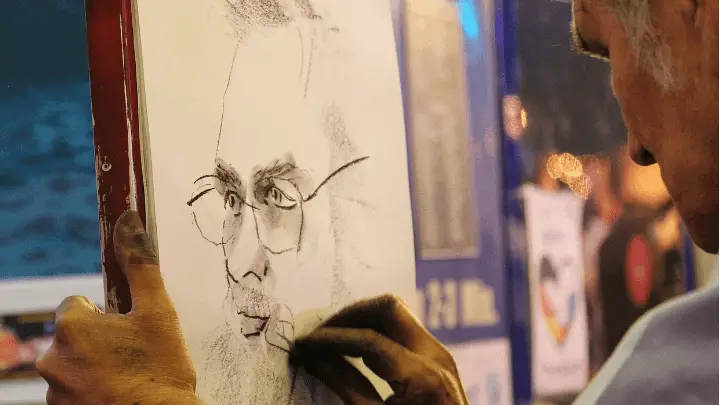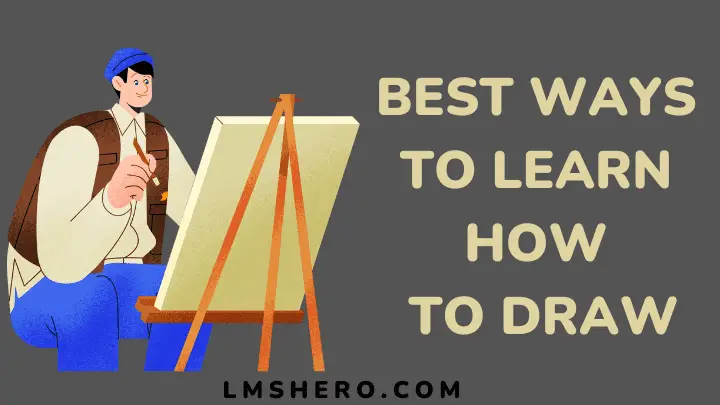There’s a lot of advice about the best ways to learn how to draw, and it can be tough to sort through the good from the bad.
I’ve put together this guide to help you get the most out of your drawing lessons.
There is something here for everyone, whether you want to explore something new and unique or try a tried-and-true method that has worked for others.
The following are some of the best ways to learn how to draw:
1. Join a course or an art club
Even if you’re not planning to use the art for a career, there’s no doubt that learning how to draw is an important skill. And there’s no better way to learn than from experienced artists.
Consider joining a course or art club. There are many types of courses and art clubs available, so there is sure to be perfect for you.
Doing so will allow you to learn from professional artists and meet other people who love drawing.
You will also have the opportunity to share your work with others, which will help you to develop your skills and improve your techniques.
And when you’re finished, you’ll have a portfolio full of beautiful drawings that you can show off to the world.
2. Progress methodically from basic to advanced levels
There’s something undeniably satisfying about gradually building upon your knowledge, mastering new skills, and understanding complex concepts.
This is why so many artists start by learning to draw basic shapes. It’s the first step on the path to becoming a better artist. Drawing basic shapes teaches you how to organize your thoughts.
Furthermore, it gives you a foundation to build more complicated designs. The lessons become even more helpful as you progress from the basic to the advanced levels.
You learn to use composition, perspective, and color theory and develop more vital skills with shading, detail, and line work.
By starting with the basics, you’ll be able to apply those techniques more efficiently and effectively. And the better you know how to use those techniques, the more fun drawing will be.
3. Learn from imitating photos
If imitation is the sincerest form of flattery, then learning from imitating photos must be one of the best ways to learn how to draw.
When you study the work of masters like Picasso, you’re borrowing their techniques and skills. By studying their drawings closely, you can learn how to create shapes and forms, value light and shadow, and understand perspective.
In other words, you’re taking advantage of one of the most powerful tools at your disposal – imitation.
So grab a pencil and some paper, and start copying the illustrations that interest you the most. You might be surprised at how much you’ll learn in the process.
4. Watch an instructional video on YouTube
Learning to draw is a skill anyone can enjoy, regardless of their experience or skill level. That’s why I recommend watching instructional videos online.
They’re simple to follow and provide clear, concise instructions that are easy to understand. From the time we’re babies, we’re captivated by videos. We watch them learn, be entertained, and for inspiration.
There’s something about seeing concepts and techniques step-by-step that makes them easier to remember and apply.
And with YouTube, you can learn how to draw in just minutes, with exercises that build on each other until you’ve mastered the skill.
So don’t hesitate to start learning how to draw today by watching an instructional video on YouTube.
5. Use software that assists with learning
Conscient practice is no substitute if you want to learn how to draw. But that can be tough to do when you’re bored or struggling to understand the basics.
That’s where software such as Hourglass, ArtRage, Adobe Photoshop, and Corel Paint Shop Pro, among others, helps you draw.
First, it simplifies complex concepts, so you can better grasp them. Furthermore, it provides visual feedback, so you can see what you’re doing and make corrections as needed.
Likewise, it challenges your technology skills continually, so you never outgrow what you’re learning.
And lastly, it provides a wealth of instructional resources, so you can keep learning even when you’re not at your desk.
However, despite the software’s effectiveness, you should learn to rely on your drawing skills rather than tools.
6. Gain more creativity and fluidity by drawing freehand
Learning to draw freehand gives you a sense of control and flexibility that you don’t get when learning from a model. This isn’t just true for beginners—even experienced artists can benefit from practicing freehand.
Drawing freehand helps you develop better observational skills, which are essential for drawing realism. When you practice freehand, you also increase your ability to express yourself creatively.
By focusing on the process rather than following a specific formula, you’re more likely to come up with unique and exciting ideas.
Finally, drawing freehand is a tactile experience that can help you learn how to sense proportions. By exploring the boundaries of your imagination, you’ll be able to create more realistic drawings.
7. Stay creative and experiment with different techniques
Creativity isn’t a one-size-fits-all approach. No matter what you do, there’s always room for improvement.
There’s no such thing as a perfect solution, and that’s why experimentation is so necessary.
When constantly trying new things, you’re never stuck in a rut. You can keep growing and learning, and eventually, you’ll reach your full potential.
8. Draw from memory or imagination
There’s something special about drawing from memory or imagination. When you draw from memory, you can create anything you want. You are in control.
And that’s what makes drawing from memory so powerful. It’s like building a model of the world. You can explore every detail and learn whatever you need to know.
You can build models of people, buildings, and landscapes. You can learn how to draw animals, trees, and flowers. And you can even create your scenes.
You can just let your imagination run wild. And that’s why drawing from memory or imagination is one of the best ways to learn how to draw.
9. Attend art exhibits and critique each other’s work
Art is a way of looking at the world that can open your eyes to new perspectives.
An excellent way to learn how to draw is through art exhibitions and critiques, whether you’re improving your skills or exploring others’.
Not only will you get direct feedback on your work, but you’ll also be exposed to different styles and techniques.
By sharing your thoughts and observations with others, you better understand how to use your skills. In the end, this helps us become better artists.
So go ahead—indulge your passion for art. It might just be the best lesson you ever learn.
10. Practice every day
The best way to learn how to draw is to practice every day. This isn’t a soft suggestion – it’s a fact.
Practice makes perfect, and what starts as an easy practice will eventually become harder and harder until you can produce high-quality work. The more you practice, the better your skills will become.
You’ll be able to see your mistakes and fix them, and you’ll develop a better understanding of the principles of drawing. Eventually, you’ll be able to create any image your heart desires.
You don’t have to be an artist to see this value; anyone can benefit from practicing their skills. So start practicing today, and see how your drawings will improve.

FAQs
Is drawing hard?
Yes. However, drawing is just like anything else: it takes effort to get good at it.
How long does it take to learn to draw?
It can take up to six months to learn how to draw, depending on your experience level, effort, and dedication.
Is drawing talent or skill?
Some people believe that drawing is a talent, while others believe it is a skill. The truth is, it is a bit of both.
Drawing is a skill that can be learned, and anyone can become a great artist with practice.
Are there any mental benefits of drawing?
Evidence shows that drawing can provide mental benefits, such as reducing stress and improving cognitive function.
Final thoughts
There is no single way to learn how to draw, as different approaches work for different people.
Some people want to watch illustrated tutorials, while others prefer more hands-on learning with practice drawings.
There are plenty of resources available to help you find the method that works best for you. The most important thing is to find something you enjoy that will help you achieve your goals.
If you have a drawing you’ll like to showcase, it’s essential to know how to market it at an art gallery. If this piques your interest, you can learn how art galleries make money. As a result, you’ll be able to make an informed decision.
Thanks for reading.






